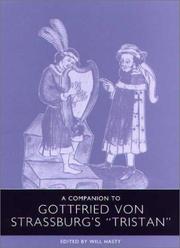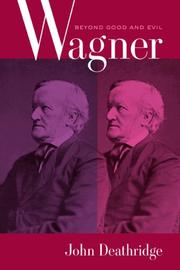| Listing 1 - 4 of 4 |
Sort by
|
Book
ISBN: 1281999679 9786611999674 3110212226 9783110212228 9783110200287 3110200287 Year: 2008 Publisher: Berlin New York Walter De Gruyter
Abstract | Keywords | Export | Availability | Bookmark
 Loading...
Loading...Choose an application
- Reference Manager
- EndNote
- RefWorks (Direct export to RefWorks)
Im Rahmen seines Kulturprogrammes und der Europäisierung des norwegischen Königshofes ließ König Hákon Hákonarson (geb.1204) kontinentale, insbesondere französische Literatur ins Norwegische übersetzen, darunter die Geschichte von Tristan und Isolde des Thomas de Bretagne. Die norwegische Tristram saga ist von zweifacher Bedeutung: Dokument des Kulturimportes vom Kontinent in den Norden und einzige Quelle für die Rekonstruktion von Thomas' Werk, das bis auf einige Zeilen verloren ist. Von den Lais der Marie de France ist ein Text ebenfalls im 13. Jahrhundert ins Norwegische übersetzt worden. Aus dem 15. Jahrhundert ist eine selbständige isländische Tristrams saga überliefert, die als Reaktion, vielleicht sogar Parodie auf die norwegische Saga verstanden werden muss. Von der Beliebtheit des Stoffes zeugen weiterhin die isländischen, dänischen und färöischen Volksballaden, die ihn in teilweise eigenwilligen Fassungen gestalten. Alle diese Texte werden hier zum größten Teil erstmals in deutscher Übersetzung im Zusammenhang präsentiert.
Scandinavian literature --- German influences. --- Gottfried, --- Tristan --- Drustanus --- Drystan fab Tallwch --- Tristram --- Tristran --- Tristain --- Trystan --- In literature. --- Tristrams saga --- Saga af Tristram og Ísönd --- Tristrams saga og Ísöndar --- Criticism, interpretation, etc. --- History of literature. --- Scandinavia (literature). --- Tristan and Isolde (in literature). --- Tristan (Legendary character) in literature. --- in literature.

ISBN: 1571132031 1571136045 Year: 2003 Publisher: Woodbridge, Suffolk ; Rochester, NY Camden House
Abstract | Keywords | Export | Availability | Bookmark
 Loading...
Loading...Choose an application
- Reference Manager
- EndNote
- RefWorks (Direct export to RefWorks)
The legend of Tristan and Isolde -- the archetypal narrative about the turbulent effects of all-consuming, passionate love -- achieved its most complete and profound rendering in the German poet Gottfried von Strassburg's verse romance Tristan (ca. 1200-1210). Along with his great literary rival Wolfram von Eschenbach and his versatile predecessor Hartmann von Aue, Gottfried is considered one of three greatest poets produced by medieval Germany, and over the centuries his Tristan has lost none of its ability to attract with the beauty of its poetry and to challenge -- if not provoke -- with its sympathetic depiction of adulterous love. The essays, written by a dozen leading Gottfried specialists in Europe and North America, provide definitive treatments of significant aspectsof this most important and challenging high medieval version of the Tristan legend. They examine aspects of Gottfried's unparalleled narrative artistry; the important connections between Gottfried'sTristan and the socio-cultural situation in which it was composed; and the reception of Gottfried's challenging romance both by later poets in the Middle Ages and by nineteenth- and twentieth-century authors, composers, and artists -- particularly Richard Wagner. The volume also contains new interpretations of significant figures, episodes, and elements (Riwalin and Blanscheflur, Isolde ofthe White Hands, the Love Potion, the performance of love, the female figures) in Gottfried's revolutionary romance, which provocatively elevates a sexual, human love to a summum bonum.
Will Hasty is Professor of German at the University of Florida. He is the editor of Companion to Wolfram's "Parzival," (Camden House, 1999).
Gottfried von Strassburg --- Tristan (Legendary character) --- Romances --- History and criticism --- Arthurian romances --- History and criticism. --- Gottfried, --- German poet. --- Gottfried von Strassburg. --- Grail legend. --- Hartmann von Aue. --- Richard Wagner. --- Tristan and Isolde. --- Wolfram von Eschenbach. --- adultery. --- love. --- medieval epic. --- romance. --- sexual love. --- summum bonum. --- Tristan
Book
ISBN: 9781800103634 9781580469999 1800103638 158046999X Year: 2021 Publisher: Rochester University of Rochester Press
Abstract | Keywords | Export | Availability | Bookmark
 Loading...
Loading...Choose an application
- Reference Manager
- EndNote
- RefWorks (Direct export to RefWorks)
Here translated for the first time, Jean-Jacques Nattiez's widely hailed comparative guide to the techniques of music analysis focuses on a single vivid passage from Wagner's Tristan and Isolde.
Musical analysis --- Analysis, Musical --- Analytical guides (Music) --- Hermeneutics (Music) --- Music --- Music analysis --- Music theory --- Music appreciation --- Analysis, appreciation --- Analytical guides --- Instruction and study --- Wagner, Richard, --- Musical analysis. --- Music analysis. --- Richard Wagner. --- Tristan and Isolde. --- Wagnerian opera. --- music criticism. --- music history. --- music interpretation. --- music scholarship. --- music theory. --- musical techniques. --- musicology.

ISBN: 1281752665 1435684761 9786611752668 052093461X 9780520934610 9781281752666 9781435684768 6611752668 9780520254534 0520254538 Year: 2008 Publisher: Berkeley University of California Press
Abstract | Keywords | Export | Availability | Bookmark
 Loading...
Loading...Choose an application
- Reference Manager
- EndNote
- RefWorks (Direct export to RefWorks)
John Deathridge presents a different and critical view of Richard Wagner based on recent research that does not shy away from some unpalatable truths about this most controversial of composers in the canon of Western music. Deathridge writes authoritatively on what Wagner did, said, and wrote, drawing from abundant material already well known but also from less familiar sources, including hitherto seldom discussed letters and diaries and previously unpublished musical sketches. At the same time, Deathridge suggests that a true estimation of Wagner does not lie in an all too easy condemnation of his many provocative actions and ideas. Rather, it is to be found in the questions about the modern world and our place in it posed by the best of his stage works, among them Tristan und Isolde and Der Ring des Nibelungen. Controversy about Wagner is unlikely to go away, but rather than taking the line of least resistance by regarding him blandly as a "classic" in the Western art tradition, Deathridge suggests that we need to confront the debates that have raged about him and reach beyond them, toward a fresh and engaging assessment of what he ultimately achieved.
Opera --- Wagner, Richard, --- Wagner, Wilhelm Richard, --- Drach, Wilhelm, --- Fājner, Rītshārd, --- Vāgners, Richards, --- Vagner, Rikhard, --- Vagner, R. --- Wagner, R. --- Wagunā, R., --- Vagneri, Rihard, --- Wagner, Riccardo, --- ואגנר, ריכארד, --- ואגנר, ריכרד, --- Criticism and interpretation. --- classical music. --- controversial composer. --- deathridge. --- der ring des nibelungen. --- engaging assessment. --- famous classical composers. --- music appreciation. --- music history. --- performing arts. --- provocative actions. --- tristan and isolde. --- understanding wagner. --- unpublished musical sketches. --- wagner. --- western art tradition. --- western music canon.
| Listing 1 - 4 of 4 |
Sort by
|

 Search
Search Feedback
Feedback About UniCat
About UniCat  Help
Help News
News